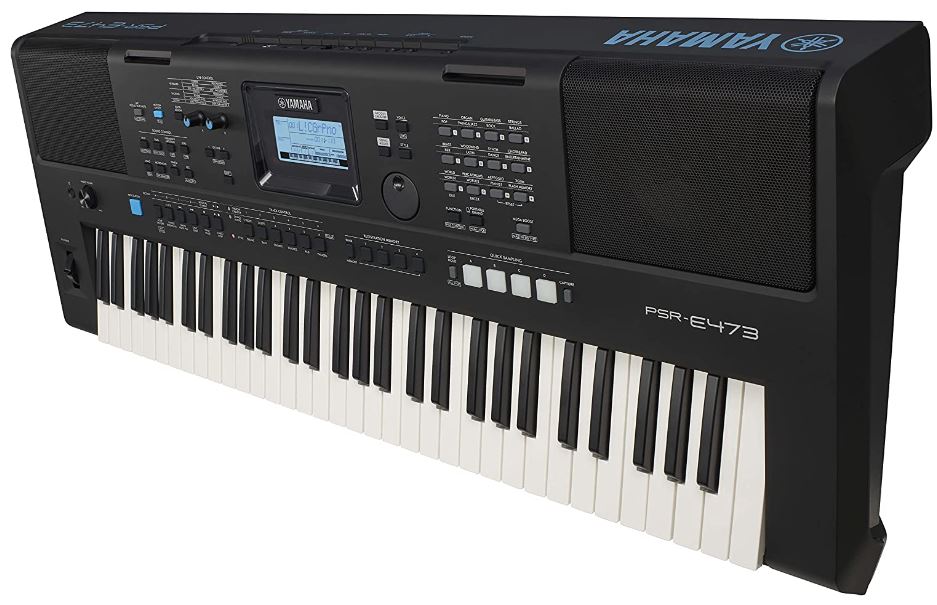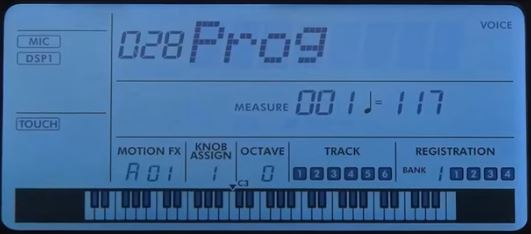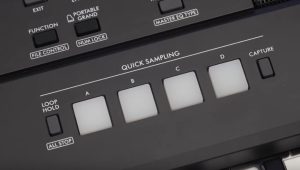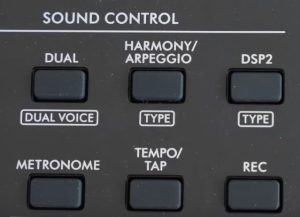As an avid pianist and music enthusiast, I recently had the opportunity to test and explore the Yamaha PSR-E473, a member of the renowned PSR series by Yamaha. Yamaha has long been recognized as a leader in the musical instrument industry, known for their commitment to quality and innovation. The PSR series (read my Yamaha keyboards overview here) which includes PSR-E273, PSR-E373 and PSR-E473 has gained popularity among beginners and intermediate players for its affordability and feature-packed keyboards.
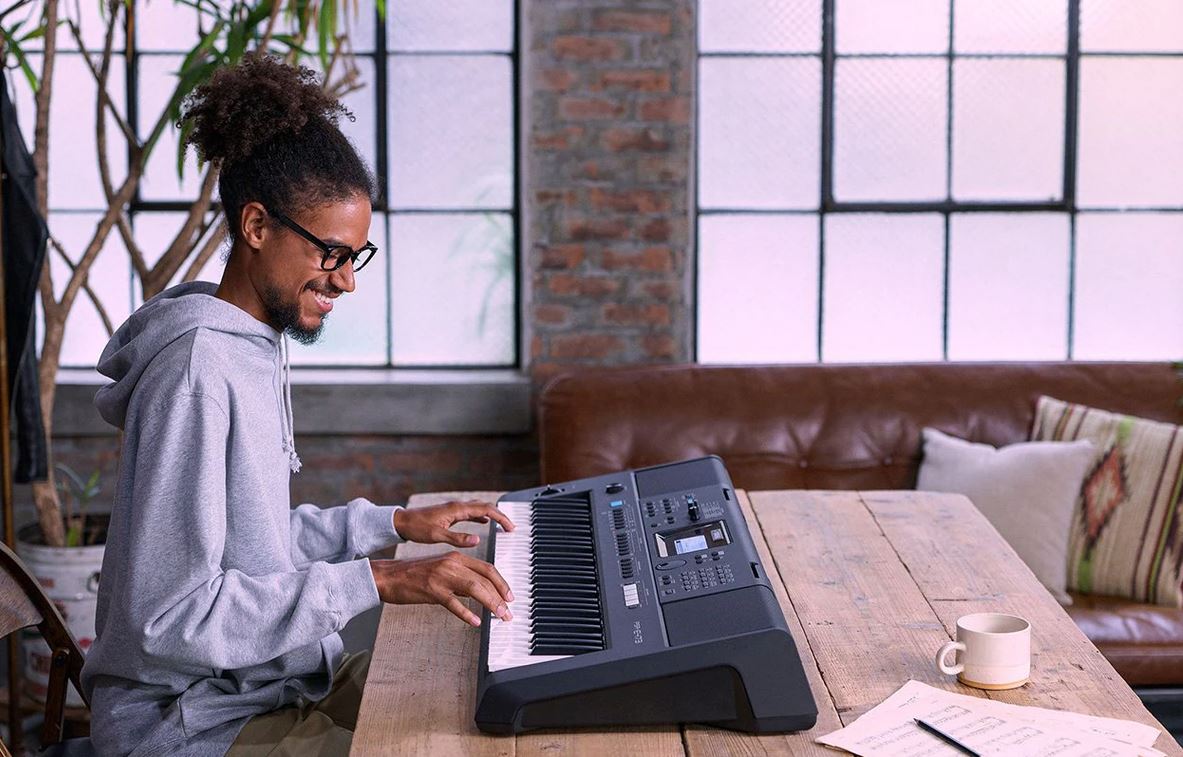
PSR-E473 (the recently updated PSR-E463) and PSR-EW425 (the 76 key version of the keyboard, the updated version of PSR-EW410) are flagships of PSR-E series. They got a newly developed tone generator that brings remarkable enhancements to sound quality and effects that add depth and richness to the overall audio experience. There are also some other improvements, but let’s start from the beginning.
Table of Contents
PSR-E473 Main Specs
| Release Date | 2022 |
| Keyboard | 61 key non-weighted organ-style with touch response |
| Polyphony | 64 |
| Voices | 820 |
| Rhythms | 290 |
| Super Articulation Lite Voices | 14 |
| User songs | 10 songs (19000 notes), 6 tracks |
| Effects | DSP1 (41), DSP2 (12), Reverb (12), Chorus (5), Master EQ (4) |
| Dual mode | Yes |
| Split/Layer mode | Yes |
| Other features | Mega Boost, Motion Effects (57 types), Quick Sampling, Groove Creator, Live Control Knobs |
| Sampling Sources |
|
| Pedal included | No |
| Built-in speakers | Yes (2x6 W, 2x12 cm) |
| Connections |
|
| Battery support | 6 AA size |
| Weight | 15.5 lbs (7 kg) |
| Dimensions (without stand) (WxDxH) | 39-1/16”x5-3/8”x15-7/8” (992x136x404 mm) |
Design/Portability
The Yamaha PSR-E473 as the whole PSR series boasts an elegant and sleek design, with a lightweight construction that makes it highly portable. It has a clean and contemporary look. Its compact size and fairly light weight (the PSR-E473 weighs 15.5 pounds, PSR-EW425 – 18 pounds) allows for easy transportation, making it ideal for both practice sessions at home and performances on the go. The instrument is crafted with durability in mind, ensuring it can withstand the rigors of daily use.
The only thing I could complain is the LCD display which looks like it’s from the 90s. It has been slightly updated in terms of the amount of information it displays, but still this is not a color touch-screen as on higher Yamaha models. Well, PSR is not professional series, so this shortcoming must be dealt with.
The buttons of PSR-E473 are grouped according to the functions they control. On the left side and below the LCD display there are blocks of sound and styles/auto accompaniment control. On the right side there are sampling buttons, registration memory and voice/style/function navigation keyboard. Also, there is a big rotary switch for selecting various options, depending on the chosen mode.

As in the previous model there are 2 handy assignable live control knobs to the left of LCD display which you can use to adjust effects on the fly.
Keyboard
Both PSR-E473 (61 keys) and PSR-EW425 (76 keys) feature a touch-sensitive keyboard, offering a responsive and dynamic playing experience. The keys are full-sized organ-style, have a comfortable feel and good tactile response, allowing for expressive playing and a sense of control over the music. Whether you’re playing soft melodies or energetic passages, the keyboard responds accurately to your touch.
Both keyboards are not weighted or semi-weighted, so don’t count on the feel of playing a real piano. Changing touch-sensitivity to Hard could help a little, but only in terms of sound, not the feel of key touch.
Voices, Sound Quality, Speakers
One of the highlights of the Yamaha PSR-E473 keyboard is its wide range of voices and sound quality. With over 820 instrument voices, including realistic piano sounds, the keyboard offers a versatile palette for musical expression.
The voices are divided into categories: Piano&Electric Piano, Organ, Guitar&Bass, Strings, Brass, Woodwind, Choid&Pads, World. Each category can be selected with a one-touch button on a panel and includes dozens of voices.
 The main piano sample on E473 is the “Live! Concert Grand”. It was first introduced on PSR-E373 and now became even better because of increased polyphony and newer processor. The sample sounds great: if you listen to it with your eyes closed you will hardly notice that you listen to a $400-keyboard, not a $1000 portable grand.
The main piano sample on E473 is the “Live! Concert Grand”. It was first introduced on PSR-E373 and now became even better because of increased polyphony and newer processor. The sample sounds great: if you listen to it with your eyes closed you will hardly notice that you listen to a $400-keyboard, not a $1000 portable grand.
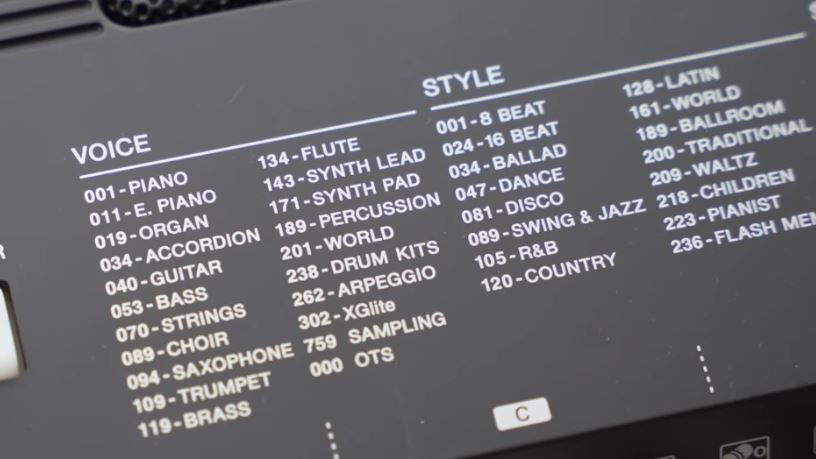 “Super Articulation Lite” voices are also present in this model, as well as in previous PSR-E463: this feature which adds special “live” effects of playing particular instruments (breaths, taps, slides, knocks). PSR-E473 has 14 Super Articulation Lite voices.
“Super Articulation Lite” voices are also present in this model, as well as in previous PSR-E463: this feature which adds special “live” effects of playing particular instruments (breaths, taps, slides, knocks). PSR-E473 has 14 Super Articulation Lite voices.
There are multiple DSP effects (DSP1 – 41 types, DSP2 – 12 types), various Reverb, Chorus effects and 4 types of EQ. The sound quality is impressive, with rich and dynamic tones that capture the essence of each instrument.
Built-in speakers (2×6 Watts for PSR-E473 and 2×12 Watts for PSR-EW425) deliver clear and well-balanced audio, providing an immersive experience even without external amplification. And new Mega Boost button increases volume of internal speakers even more.
Additional Features
The PSR-E473 comes equipped with a variety of additional features that enhance the playing experience. Let’s discuss most noticeable of them.
Layer/Split
No one is surprised by Layer/Split functionality of the keyboard of this class. The PSR-E473 is no exception. For those who don’t know I will remind that Layering allows to combine 2 voices and play them simultaneously and Splitting divides your keyboard into 2 parts to play one voice with the left hand and another voice with the right. Of course you can assign different effects to both voices, change the split point, and more.
Quick Sampling
As the previous model does, PSR-E473 also has quick sampling feature. There are 4 buttons which can be assigned your own sample (even recorded from the Microphone) or use built-in samples. The sample is played whenever you press the button until you release it. There is also a loop mode so that you don’t need to hold the button all the time. You can press multiple sampling buttons and play the assigned samples in the mix.
Groove Creator
Another nice feature which is unique to the PSR-E400 series is Groove Creator. I am not an electronic music fan, so I won’t tell you much about it. But the feature is easy to use and creates nice electronic grooves using the 35 built-in grooves in 5 groove categories. You can choose from multiple styles, mute and un-mute tracks, assign effects, play along on the keyboard or add recorded samples using Quick Sampling feature. Sounds good!
Motion Effects
Motion Effects is a feature used to apply dynamic effects to your performance. For example you can use it together with Groove Creator. The live effect is applied while you hold the Motion Effect button. Depending on the type of effect it can be applied either to the whole mix, or just to those parts you select, for example just to the voice you play on the keyboard, or the sounding Sample.
Live Control Knobs
The two Live control knobs allow you to control 7 different functions each with its own effect:
3 functions for Voices you play on the keyboard:
- Cutoff, Reverb, DSP1 Parameter A for the Knob A
- Resonance, Chorus, DSP1 Parameter B for the Knob B
3 functions for Styles and Grooves:
- Cutoff, Reverb, Volume Balance
- Resonance, Chorus, Retrigger Rate
1 function for the system (DSP parameters).
You can assign the function by pressing Knob Assign button.
If you connect external source to the AUX In port, one of the Knob A functions can be used to control the volume of the backing AUX sound which is very useful. And the Retrigger Rate function of Knob B can be used in Groove Creator to control the retrigger speed of the beat.
Recording
You can record up to 10 tracks of your live performance into the built-in memory of your PSR. But the recording and editing tracks using PSR-E473 small LCD display is quite a difficult task. With many DAW apps you can do it in a much more convenient way on your computer using the provided MIDI connectivity. And with the built-in audio interface you can record high-quality audio directly to flash drive.
Connectivity
The Yamaha PSR-E473 offers a range of connectivity options to enhance your musical experience and provide versatility in connecting with external devices. Here are the connectivity features of the PSR-E473:
- USB to Host: The USB to Host port allows for seamless connection to a computer or iOS device. This enables you to easily integrate the keyboard with music software, record your performances, and utilize educational tools or virtual instruments. USB-to-Host in PSR-E473 has an integrated audio interface. That means you can not only transmit MIDI data to or from your external device, but to transmit also audio data (the sound you hear) in both directions through this interface.
- USB to Device: This port allows you to connect USB flash drives to the keyboard to record your performance
- AUX Input: The PSR-E473 includes an AUX input that enables you to connect external audio sources such as smartphones, tablets, or music players. This allows you to play along with your favorite songs or practice with backing tracks, enhancing your overall musical creativity.
- Headphone Output (standard mini jack): The keyboard features a headphone output for private listening. This is particularly useful for late-night practice sessions or when you don’t want to disturb others around you. It provides a clear and immersive audio experience, allowing you to focus solely on your playing.
- Sustain Pedal Input: The PSR-E473 has a sustain pedal input, giving you the option to connect a foot pedal for enhanced expression and control over sustained notes and chords.
- Output (standard phone jack) x2
- Microphone (standard phone jack). This input has individual gain knob, volume control and assignable effects. There is also a mute button on the panel. That means your keyboard can work as a small mixer which is a big advantage if you are a solo keyboardist-singer: now you can use only your PSR to play along with your singing. There is no need for external mixer or PA system if the internal speakers power is enough for your performance.
These connectivity options open up a world of possibilities for the PSR-E473, allowing you to connect to various devices and expand your musical capabilities. Whether you want to record your performances, play along with your favorite tracks, sing along with your playing, or practice silently with headphones, the PSR-E473 offers the necessary connectivity features to accommodate your needs.
PSR-E473 and PSR-EW425 – How do they differ?
The Yamaha PSR-E473 and PSR-EW425 are both digital keyboards that offer a range of features for musicians. While they are mostly identical, there are several differences between the two models.
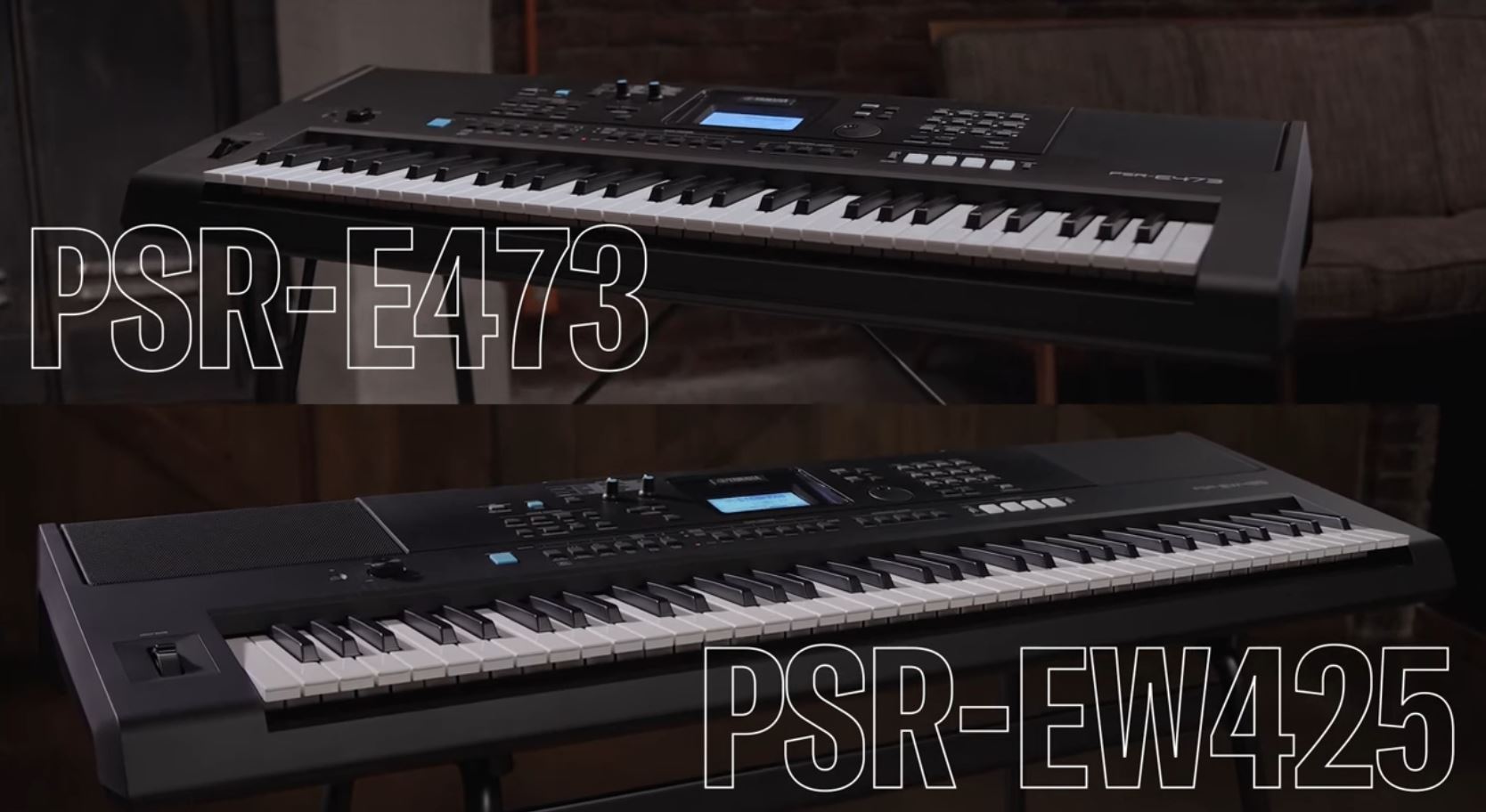
- Number of Keys: the most significant difference, which may be crucial for some of you and for me personally. The PSR-E473 features a 61-key keyboard, while the PSR-EW425 comes with 76 keys. Since I am mostly a piano player I prefer 88 keys, 61 is not enough for me, but 76 might be a compromise.
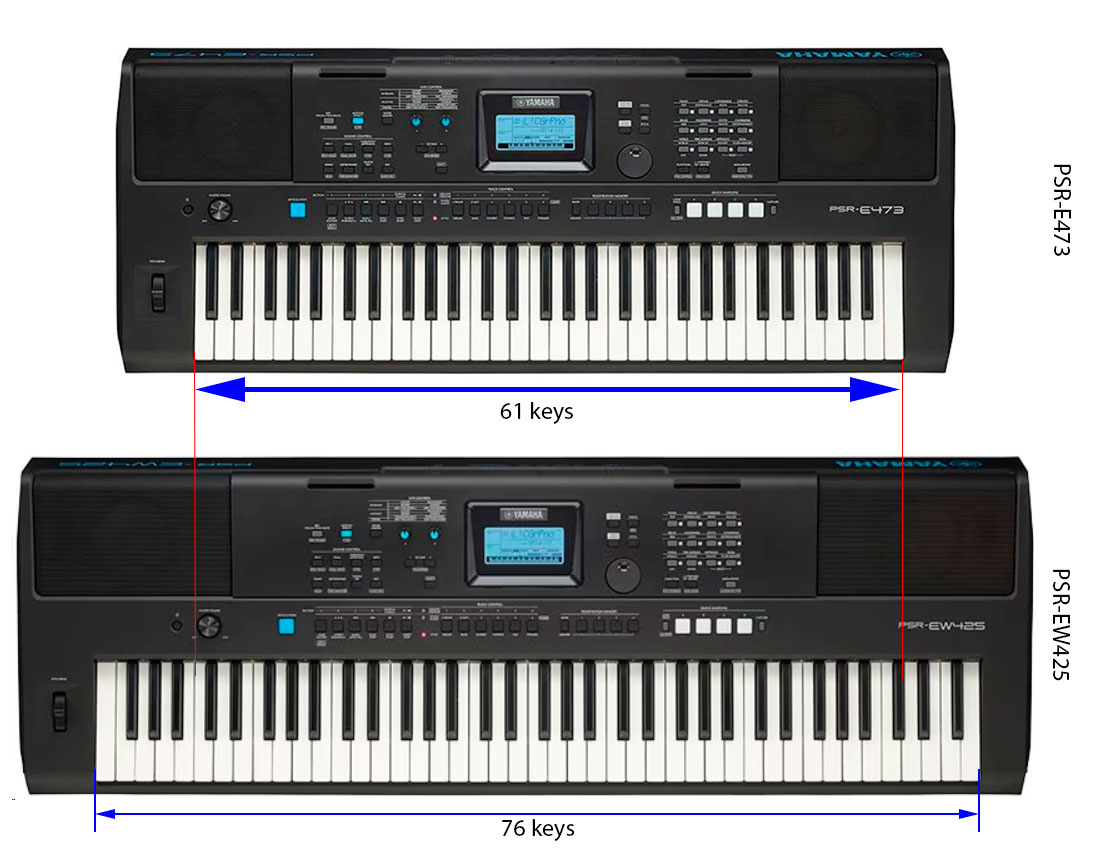
- Speaker Power: The PSR-EW425 features a higher speaker power (2×12 Watts), delivering a more robust and immersive sound experience. This can be particularly advantageous for performances in larger spaces or when playing with other musicians. The PSR-E473 has two 6 Watts speakers which is also more than enough for home performances. Because of different amplification system the PSR-EW425 requires more powerful 16 Volt power adapter and 6 D-size batteries for autonomic power. PSR-E473 uses 12 Volt PA and 6 AA-size batteries.
- PSR-EW425 has 1 enhanced piano sound (voice number 2 – Live Grand Piano) vs classic Grand Piano sample in PSR-E473. Also there are 11 upgraded organ voices. The difference between the voices on these two keyboards is in the details and is not VERY noticeable, but still may influence your choice if you are a perfectionist
- Since PSR-EW425 is about 8” wider than PSR-E473, obviously it weighs more: 18 pounds versus 15.5, respectively. The width and thickness of these 2 keyboards are equal.
It’s important to consider your specific needs and preferences when choosing between the PSR-E473 and PSR-EW425. If you prioritize a larger keyboard size, more powerful amplifier, and slightly improved organ samples, the PSR-EW425 may be the better choice. On the other hand, if portability and price are more important to you, the PSR-E473 could be a suitable option.
PSR-E473 vs PSR-E463 – Is it worth upgrading?
For those of you who are using the previous model in the series – PSR-E463 – I will highlight the most notable differences between this model and the PSR-E473. For clarity, I’ve put all the main differences in to the table and will discuss it below.
Both keyboards have the same key action with configurable 4 levels of sensitivity.
Both keyboards feature a sleek and modern design that is visually appealing. However, the PSR-E473 has a slightly updated aesthetic with a refreshed panel layout and a more streamlined appearance. It has a clean and contemporary look that adds a touch of elegance.
The LCD display though still looks like something from the 90s, is slightly enlarged on the new model and now fits more information. The user interface became more convenient and user-friendly in the new model. The updates in the interface which caught my attention:
- E473 now has category buttons to quickly jump to desired category
- E473 display now shows the bank number you are currently in. The E463 display didn’t have this information, and this was often embarrassing: it was not clear which bank you were currently working.
- E473 has buttons for quick octave shift: now you don’t have to dive deep into the menu to change octave
In terms of portability, both models are considered lightweight and easy to transport. The PSR-E473 weighs approximately 15.5 lbs (7.0 kg), while the PSR-E463 weighs slightly less at around 14.5 lbs (6.6 kg). This makes them both suitable options for musicians on the go, whether it’s for practice sessions, rehearsals, or performances.
PSR-E473 also has a newer sound processor, 62 additional sounds, and increased polyphony (from 48 to 64), because of that the voices sound more natural then on PSR-E463. The main Grand piano voice on the PSR-E473 has also been improved.
Both PSR-E463 and PSR-E473 have a number of effects (Reverb, Chorus), but the most noticeable difference is that PSR-E473 has 2 layers of DSP effects, that means two effects can be layered and sound simultaneously. Even the legacy styles and voices now sound better and more powerful with these DSP effects and new sound chip: this is great for the keyboard for this price.
PSR-E473 has two more live control buttons: Articulation and Motion Effect. And the new Mega Boost button, which increases the output volume, but it only applies to built-in speakers, not to external speakers or phones.
If we are talking about connectivity the old PSR-E463 doesn’t have Microphone input and Line outputs which may be important to you.
Number of style variations didn’t change: PSR-E473 still has 2 style variations with 1 intro and 1 ending. But another nice feature added to the PSR-E473 is the ability to re-voice instruments used in existing styles. You also have 10 free slots for additional styles, which can be downloaded from the Internet.
With all the improvements, it’s no surprise that the E473 weighs 1 pound more than the E463. The price of the new model is also a bit higher.
Ultimately, the choice between the PSR-E473 and PSR-E463 depends on personal preferences and specific needs. Both keyboards are available to buy (at the time of the article – 2023), a little more time should pass before the old model is no longer produced. But I am sure that even after that the PSR-E463 will be delighting its owners, those who are not ready to change it now for a newer one, for a long time. So if a slightly lighter weight and cheaper price are more desirable, than the new sound effects, microphone input and more powerful speakers of the PSR-E473 then the previous E463 would be the better choice for you.
Final Verdict (Overall Impression)
After some testing I am impressed with the Yamaha PSR-E473. It is a versatile and feature-rich keyboard that caters to the needs of beginners and intermediate players. The combination of quality sound, expressive touch-sensitive keys, and a wide range of voices make it a joy to play and explore different musical genres – classic and electronic as well. Live voices with Super Articulation Lite feature sound just as live instruments covering every detail of the sound produced by a particular instrument. Its portability and additional features further enhance its appeal, making it an excellent choice for both practice and performance.
If you liked PSR-E473 and 61 keys is not enough for you, you can go for PSR-EW425 – same keyboard by functionality but with increased number of keys. No matter which model you choose, I am sure that it will delight you for many years to come!
Pros/Cons
Pros
- Impressive sound quality with a wide range of voices (including great sounding Live voices) and styles
- Top-notch grand piano voice
- Touch-sensitive keys
- Compact and portable design for easy transportation
- Many connectivity options, including Microphone input with gain and effects, USB to Device port, individual L/R outputs
- Built in USB audio interface.
- Can be battery powered
Cons
- Limited number of keys (61 for PSR-E473) and non-weighted keyboard may be restrictive for advanced players.
- Old-style LCD display (though still nice user interface)
- After a few months of use some users complain on the faulty display. But Yamaha seems to fix this issue on keyboards produced since the end of 2022, so I personally have not experienced this.
Check Yamaha PSR-E473 price on Amazon here.
If you liked the review please Share or Tweet it with the button below. This way I will know that I do something useful)





Tags: 200-500 USD, onboard speakers, polyphony 48, touch sensitive keys, Yamaha
